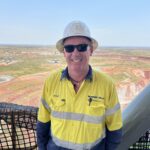TANAMI’S GOLDEN FUTURE
One of the largest mine expansion projects in Australia is marching ahead quietly and efficiently in the Northern Territory Outback.


There are exciting plans ahead for the future of Newmont Tanami that will deliver even more significant benefits to the Territory.
Global mining company Newmont is spending $2.3 billion on increasing gold production at their Tanami mine, about 550 kilometres north-west of Alice Springs, while at the same time reducing costs and emissions through innovative engineering.
The project, which is called Tanami Expansion 2 (TE2), is 40 percent complete and should be finished in late 2026 or early 2027.
TE2 is Newmont’s biggest capital expenditure project underway in Australia and represents a major investment in the future of Newmont’s Tier One operations.
About 600 workers – with 400 on site at any one time – are developing an extensive new materials handling system, involving an underground crusher, conveyors and a 1.46 kilometre-deep shaft hoisting system.
When complete, TE2 will be the deepest production shaft of any mine in Australia and its 93-metre headframe is one of the highest structures in the Territory.
About 98 percent of the workers are Australian.
“The aim is to increase production and lower costs,” says Grant Brinkmann, Newmont’s area manager of shaft and surface.
Production will be increased from 2.7 million tonnes of ore a year to 3.2 million tonnes and extend the life of the mine until 2040.
But Newmont continues to explore further gold reserves two kilometres below the surface, which means the mine life could be extended well beyond that, bringing greater wealth in services, wages, royalties and taxes to Australia and the Territory.
About 500,000 ounces of gold is produced at Tanami each year.
At the moment, ore is brought to the surface by trucks hauling 60 tonnes each at a time – a round journey of about 30 kilometres and which takes three hours.
Once on the surface, the ore is hauled 44 kilometres to the Granites plant for primary and secondary crushing, milling and processing to liberate the gold.
In future, the ore will be primary crushed and conveyed underground, then hoisted to the surface using the new shaft and friction winder.
It will take only five minutes, instead of three hours, to hoist 56 tonnes of ore to the surface.
Ore will still be taken to the Granites for secondary crushing, milling and processing.
Aside from increased production and reduced costs, there are other big benefits. Fewer truck movements means greater safety, reduced emissions – including underground – and better working conditions for Newmont’s employees.
Staff, including truck drivers, will be offered upskilling, such as learning how to operate and maintain the underground materials handling system.
Gold has been mined at Tanami since 1983 and the mine has been wholly owned by Newmont since 2002.
About 1800 fly-in fly-out workers operate the underground mine, which is one of the biggest single contributors to the NT economy through $150 million a year in royalties and taxes and significant land access agreement payments to the Warlpiri Traditional Owners.
Mine operations like Tanami also spend locally by engaging NT contractors and local suppliers, further supporting Territory industries.
About 14 percent of Tanami’s workforce is Aboriginal, with scholarships, bursaries, traineeship and mentoring programs helping attract and retain skilled workers.

